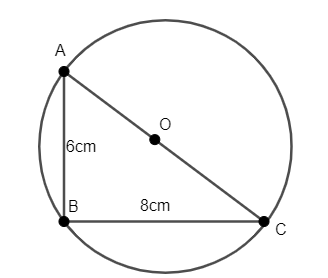
The radius of the circle, passing through the vertices of a right-angled triangle when the lengths of perpendicular sides are 6cm and 8cm is
(a) 10cm
(b) 14cm
(c) 7cm
(d) 5cm
Answer
506.6k+ views
Hint: Find the length of the hypotenuse of the right-angled triangle using Pythagorean Property. Use the fact that if the circle has to pass through the vertices of a triangle, the diameter of the circle must be equal to the length of the hypotenuse of the triangle. Divide the hypotenuse by 2 to calculate the radius of the circle.
Complete step-by-step answer:
We know that a circle passes through all the vertices of a right-angled triangle whose length of perpendicular sides is 6cm and 8cm. We have to calculate the radius of the circle.
Let’s assume that $\Delta ABC$ is the right-angled triangle, right-angled at B and the centre of the circle is O, as shown in the figure.

We observe that if the circle has to pass through the vertices of a right-angled triangle, then the diameter of the circle must be equal to the length of the hypotenuse of the triangle.
So, we will now calculate the length of hypotenuse use Pythagorean Property. In a right-angled triangle $\Delta ABC$ right angled at B, we have ${{\left( AB \right)}^{2}}+{{\left( BC \right)}^{2}}={{\left( AC \right)}^{2}}$.
Substituting $AB=6cm,BC=8cm$ in the above equation, we have ${{6}^{2}}+{{8}^{2}}={{\left( AC \right)}^{2}}$.
Thus, we have ${{\left( AC \right)}^{2}}=36+64=100$. Taking square root on both sides, we have $AC=\sqrt{100}=10cm$. Thus, the diameter of the circle is 10cm.
We will now calculate the radius of the circle. To do so, we will divide the diameter of the circle by 2.
Thus, the radius of the circle $=\dfrac{10}{2}=5cm$.
Hence, the radius of the circle is 5cm, which is option (d).
Note: We can use the fact that if the circle has to pass through the vertices of a right-angled triangle, then the diameter of the circle must be equal to the length of the hypotenuse of the triangle because $\angle ABC$ is an angle within a semicircle.
Complete step-by-step answer:
We know that a circle passes through all the vertices of a right-angled triangle whose length of perpendicular sides is 6cm and 8cm. We have to calculate the radius of the circle.
Let’s assume that $\Delta ABC$ is the right-angled triangle, right-angled at B and the centre of the circle is O, as shown in the figure.

We observe that if the circle has to pass through the vertices of a right-angled triangle, then the diameter of the circle must be equal to the length of the hypotenuse of the triangle.
So, we will now calculate the length of hypotenuse use Pythagorean Property. In a right-angled triangle $\Delta ABC$ right angled at B, we have ${{\left( AB \right)}^{2}}+{{\left( BC \right)}^{2}}={{\left( AC \right)}^{2}}$.
Substituting $AB=6cm,BC=8cm$ in the above equation, we have ${{6}^{2}}+{{8}^{2}}={{\left( AC \right)}^{2}}$.
Thus, we have ${{\left( AC \right)}^{2}}=36+64=100$. Taking square root on both sides, we have $AC=\sqrt{100}=10cm$. Thus, the diameter of the circle is 10cm.
We will now calculate the radius of the circle. To do so, we will divide the diameter of the circle by 2.
Thus, the radius of the circle $=\dfrac{10}{2}=5cm$.
Hence, the radius of the circle is 5cm, which is option (d).
Note: We can use the fact that if the circle has to pass through the vertices of a right-angled triangle, then the diameter of the circle must be equal to the length of the hypotenuse of the triangle because $\angle ABC$ is an angle within a semicircle.
Recently Updated Pages
Two men on either side of the cliff 90m height observe class 10 maths CBSE

What happens to glucose which enters nephron along class 10 biology CBSE

Cutting of the Chinese melon means A The business and class 10 social science CBSE

Write a dialogue with at least ten utterances between class 10 english CBSE

Show an aquatic food chain using the following organisms class 10 biology CBSE

A circle is inscribed in an equilateral triangle and class 10 maths CBSE

Trending doubts
Which of the following does not have a fundamental class 10 physics CBSE

Differentiate between Food chain and Food web class 10 biology CBSE

State BPT theorem and prove it class 10 maths CBSE

A Gulab jamun contains sugar syrup up to about 30 of class 10 maths CBSE

What is UltraEdge (Snickometer) used for in cricket?

Write the difference between soap and detergent class 10 chemistry CBSE




